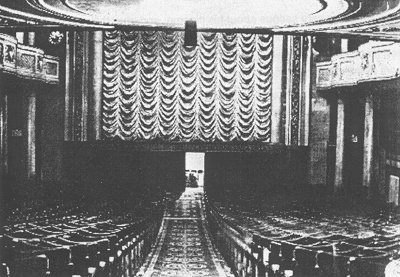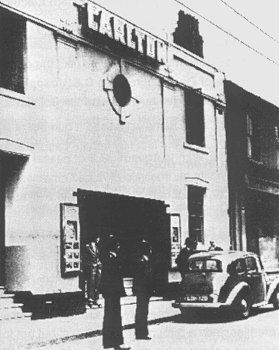Times of Change
For many of the older cinemas the first two decades of the talkies (the
30's and 40's) was a time of immense change. If we now consider those
cinemas in turn and some of those changes.
Th e Olympia remained Under the control of the
Quigley family until early in 1939 and so it was James Quigley who
oversaw the introduction of sound to the cinema in 1930. The cinema was
very fortunate to employ the services of one of the most outstanding of
local operators, Harry Poncherry. The cinema was leased to C.S.
Joseph and his Pine Pictures Company in 1939. After the war,
the cinema began to concentrate much of its effort on the provision of
Continental films (an idea of the cinema's then manager, Charles
Kettle).

June 1942.

June 1942.
The talkies arrived at the West End cinema in Whitmore Reans on April
13th 1930, although an orchestra was reintroduced to the cinema on
Friday nights in 1933. The cinema was regularly leased to various
people, including a colourful character named Capt. Bert Riego
who was especially remembered for his Saturday afternoon matinees for
children. The cinema was also the regular venue of the Wolverhampton
Film Society. During the war the West End became the property of O.G.
Pictures (a company which was under the control of Messrs. Oakey
& Godsall).

The Rex, before demolition. |
The company introduced an organ to
the cinema which was played by Arthur Collett, one
of the most popular of local musicians.On Sunday
January 16th 1944, the cinema changed its name to the Park.
The new name was almost certainly a product of the cinema's
proximity to the West Park. The cinema was to remain open as the
Park for just three years and in July 1947, it closed. One month later the cinema again re-opened, this time with
its fourth name, the Rex.
The official re-opening took place on August 10th 1947. The
local press referred to the cinema as the Little Super Cinema in
Whitmore Reans. There had been some refurbishment and a new RCA
sound system was in place. The first film at the new cinema was
'Kismet' starring Ronald Coleman (a good choice for the
cinema in Coleman Street) and Marlene Deitrich. |
The Coliseum, which had
become the property of the Quigley family in 1930, underwent a
major refurbishment before it re-opened on November 24th 1930.
The first film was 'Gold Diggers of Broadway' (the film
which included the song Tiptoe Through the Tulips). The sound
system was by Western Electric.
Madge Quigley, the daughter of the family,
personally supervised the cinema for much of the 1930's but after her
marriage, she decided it was probably in the best interests of the
cinema to lease it to Pine Pictures (like the other of the
Quigley cinemas, the Olympia). The owner of Pine Pictures was C.S.
Joseph and he decided to make a very strenuous effort to increase
the audiences at the Coliseum.
As a result, the cinema witnessed a number of publicity stunts, like
the issuing of handkerchiefs to the first fifty female patrons who
entered the cinema to see the weepie called the 'White Rose'.
It is interesting that the cinema was managed by a woman throughout the
30's and 40's (Madge Quigley and then Eleanor Webster).
The Scala followed a very uneventful life throughout the
period. It could depend on the circuit system to keep it in operation
and also, to a degree, the existence of a fairly static local
population. The cinema which may have been most
affected by the coming of the talkies and the super cinema was possibly
the Queen's.
| It had an unassailable
position as the town's premier cinema throughout the 1920's, but not
for much longer. However, it still managed to keep a respectable
size of audience, even after the building of the town centre super
cinemas. Some people regarded the Queen's as the only authentic
cinema in the town! |

The interior of the Queen's Picture House.
|

The Carlton. |
Captain Cresswell, the owner of the Globe in
Horseley Fields, decided to sell the cinema in 1937 and it was
bought by a Mr. Hawtin who came from Cannock. He carried out
a number of quite significant changes, including the laying of a
large car park at the rear of the cinema which ran from Mary Ann
Street to Gough Street. During the war, the Globe and the West End
were owned by the same people. During the war the Globe was quite
successful although it closed on two occasions. After the second
closure, the cinema re-opened as the Carlton on Sunday
November 14th 1943. It was owned by Norman Burton from
Walsall. The first film to be shown at the new cinema was
'International Squadron' starring the
future President of the USA, Ronald Reagan |
The new owner was very serious about his
cinema, and after the war, he began improving its general appearance. He
introduced neon lighting for the sign Carlton and new seating. However,
its position in Horseley Fields meant that few people from other areas
of the town went to the cinema. A very unfair product for so much hard
work.
The Theatre Royal was
involved in an interesting set of arrangements with the Savoy, both
during the super cinema's building and immediately afterwards. While the
new cinema was being built, the Theatre Royal was leased to the ABC
circuit and afterwards it returned to the Clifton circuit. It was not
until September 18th 1948 that the Theatre Royal actually became the
Clifton.
The Ideal continued showing silent films in Wednesfield for some
years after the coming of talkies. It was not until the latter part of
the 30's that the cinema was rebuilt, refurbished and had sound
installed. The new Ideal was turned around with the screen at the canal
end of the cinema and the entrance at the road end. It still held a
similar capacity of 350 people. The owner of the cinema, John France,
died during the rebuilding programme and his executors sold the cinema.
It ultimately became the property of a Solihull wastepaper merchant
named William Severn who was a devotee of cinema. He kept the
previous manager, Joe Pursehouse, in post. Despite the existence
of the neighbouring, and much larger cinema, the Regal, the Ideal
was still able to function quite successfully.
The Regal continued to enjoy local success throughout
the period, including during the war when the cinema was used for a
number of concerts, including a pantomime. The concerts were charity
occasions. The cinema's success was to continue beyond the war, mainly
as a product of the affection and loyalty of the local population to
their cinema.
In Bilston there were a number of changes. The
Alhambra's lease ended for the Wood family in 1927 and the cinema passed
through a number of hands, including Mr. Hawtin, the owner of the
Globe in Horseley Fields. Throughout the 1940's there was constant
change of ownership for the cinema.
Wood's Palace was definitely one of the area's
most impressive cinemas of the silent era, including the possession of
the largest cinema screen. The arrival of the talkies was seized on by
Thomas Wood as an -opportunity for development. Sound was installed and
the general acoustics improved. In 1933 the Palace held a twelfth
birthday party, showing the 'Good Companions'
and parading its new refurbished interior. Finally in 1936, with
Thomas Wood heavily involved in local politics, the cinema was leased to
C.S. Joseph. From September 1936, it became the Palace
cinema. Ultimately the Palace became part of the Odeon circuit and
enjoyed a very successful wartime period as the Odeon. It was
always regarded as the principal cinema in Bilston.
The Savoy was also leased to C.S. Joseph who ran the cinema
for 21 years.
 |
|
 |
Next
Page |
|
Contents |
|

































